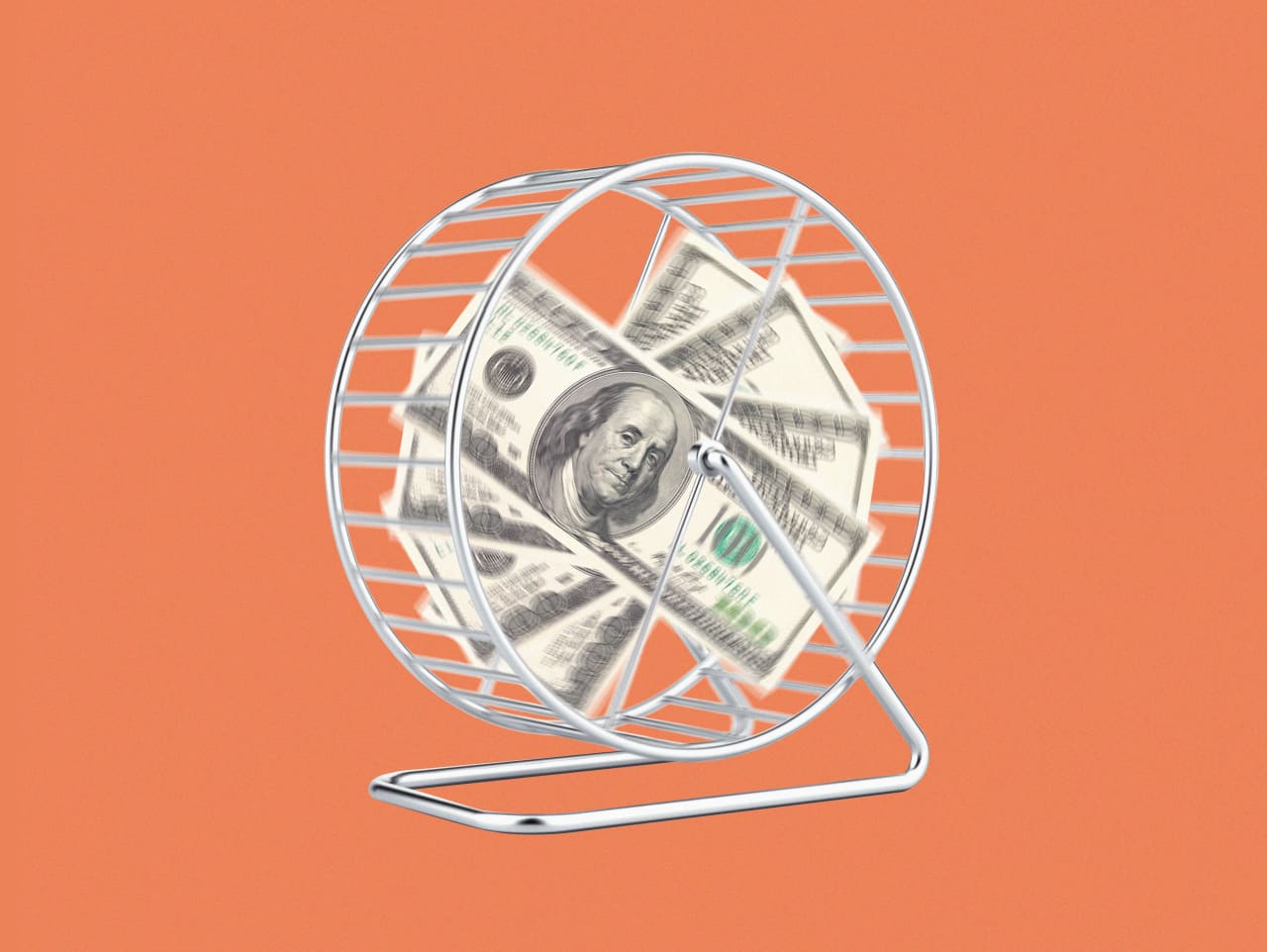15 Ways Consumers Can Deal With—and Even Benefit From—Rising Inflation
We are feeling the squeeze everywhere—from the groceries we buy to the gas we pump into cars.
Inflation stood at 9.1% in June, its highest rate in nearly 41 years. Prices for gas, rent and groceries continued to rise, according to the consumer-price index. The inflation rate is higher than the May annual rate of 8.6% that led the Federal Reserve to shift to a faster pace of interest-rate increases. The U.S. has had nine straight months of inflation above 6%, which is well above the Federal Reserve’s average 2% target.
While consumers can’t control an increase in prices, there are some things they can do—or not do—to mitigate the impact on their wallets, their budgets and even their investments. Some moves may even leave them in a better position when this inflationary period ends. We asked financial advisers, economists and others for their tips on weathering the current inflation. Here is some of their advice.
What’s your inflation rate?
Where you’re spending your money can tell you a lot about how you’re actually being impacted by inflation—and where you should focus on cutting back. To that end, it’s important to understand how inflation is measured.
The consumer-price index for all urban consumers (CPI-U), which is calculated by the Bureau of Labor Statistics, is a relatively broad measure of inflation and covers approximately 93% of the U.S. population. But while metrics like the CPI-U do a relatively good job of describing inflation for the “average” consumer, they often do a relatively poor job for individual consumers, based on their unique consumption baskets.
This is because the weights to the various items included in the CPI-U are based on data from the Consumer Expenditure Survey. For example, in the CPI-U, motor fuel represents approximately 5% of assumed total household spending and is up 44% from April 2021 to April 2022. Used cars and trucks represent approximately 4% of the total and are up 22.7% over the same period. So if you can hold off on buying a new car, for instance, you can feel less of a sting from those big increases.
Then there are certain components of inflation that tend to affect older investors more and have risen less recently. For example, medical-care services are up only 2.1% during the same period. So putting off procedures because you fear higher costs may not be worth the risk. Understanding where inflation is likely to impact you less is important, especially if the effects are relatively temporary.
- David Blanchett, head of retirement research at PGIM in Lexington, Ky.
Be aware of shrinkflation
It’s not inflation that you should be most concerned about. It’s a tactic that companies used back in the 1970s and is rearing its ugly head again: shrinkflation.
Product companies will slowly “shrink” the contents of the packages and goods you buy while charging you the same price. This means a price hike for you. The package of strawberries now has five fewer strawberries. The bag of chips has more air and less chips than usual. The roll of toilet paper went from 264 sheets to 244 sheets.
And shrinkflation doesn’t just affect what you purchase at the grocery store. The chicken parmigiana you order at your next dinner out might have two ounces less chicken, even though the price is the same. The $5 soda you order at the concession stand now has more ice and four ounces less soda.
One way to deal with shrinkflation is to try to stick with generic store brands because those tend to be the last to shrink. Additionally, pay attention to the unit price of what you are buying. Brands don’t usually downsize all of their items simultaneously, and typically the largest ones are downsized last. In some cases, whole foods may be less susceptible to shrinkage than packaged foods. It also helps to only buy fruits and vegetables that are in season.
- Ted Jenkin, co-CEO and founder of oXYGen Financial in Savannah, Ga.
Delay Social Security
For individuals who have other funds to support their retirement lifestyle, putting off collecting Social Security can be a smart inflation hedge—beyond the built-in increases in benefits tied to the consumer-price index. Every year that Social Security benefits are delayed past full retirement age, the amount of the eventual benefit increases by 8%.
Thus, an individual with a full-retirement-age benefit at 67 years of $1,000 a month could increase their benefit to as much as $1,240 by delaying to age 70—an increase of as much as 24%. And the annual CPI increase is based on this higher amount.
Once the individual lives beyond the Internal Revenue Service’s actuarial life expectancy break-even, and after adjusting for the opportunity cost of not having received those benefit payments earlier, the additional amounts can be viewed as equivalent to guaranteed “investment returns” backed by the federal government. They are guaranteed because this growth in the benefit is not subject to market fluctuations. And the longer the individual lives, the greater the returns and increasingly better inflation hedge.
- Marti Awad, senior vice president and financial adviser at Wealth Enhancement Group in Denver
Buy the car you’re leasing
Inflation data through April, based on the consumer-price index, showed that new-vehicle prices rose 13.6% since March 2021, while prices for used cars/trucks were up a whopping 34.7%. If you have a vehicle lease expiring soon, you possess a valuable way to avoid those higher prices.
That’s because your vehicle’s lease-end price was set when your lease began, prior to the current inflation. Known as the residual value, it’s the price for which you can buy your vehicle’s remaining value from the manufacturer. So in most cases, buying that vehicle is a no-brainer. Even if you have to finance the purchase from the dealer. And even if you no longer like your vehicle.
You’ll be getting an almost-new vehicle for an inflation-free price. But if you are tempted to buy a new model, you’ll have to pay a higher price that likely includes that 10% to 15% inflation increase from a year ago.
Even if you really want to get rid of it, buy it anyway. It’s now a (lightly) used vehicle whose market value has jumped about 35% in the past year. So sell it yourself, and pocket the profit on the difference before buying something else. If you simply return it to the dealer, they will do the same thing and, of course, share none of the profit with you.
- Jonathan Guyton, principal at Cornerstone Wealth Advisors in Minneapolis
Seek a higher return on happiness
When prices start soaring, my favourite defensive strategy is this: Take a moment and think about what you’re spending money on and why. And then stop spending money on the unnecessary things that don’t bring you joy. After all, if you stop spending money on something, by definition, you are no longer impacted by inflation in that area.
If this sounds suspiciously like budgeting, that’s not what I’m talking about at all. Rather, I’m encouraging you to consciously increase the “return on happiness” of each dollar you choose to spend during these inflationary times.
I can’t emphasize enough how many people tell me that when they take just a week (a month is even better) and commit to deliberately reflecting on every single expenditure made during that period—from the auto-payment on that streaming service to filling up your gas tank—transformational things can happen. When used as an opportunity to reflect broadly, gas is no longer simply gas. It’s an opportunity to consider taking public transportation, or consider whether another living or working situation may be more to your liking, or how much fresh air you experience in a day. In other words, thinking about that one expenditure allows you to rethink where you are going—literally and figuratively.
- Manisha Thakor, founder of financial well-being consultancy MoneyZen, Portland, Ore.
Ask for a raise
With the current high inflation rate, it is time for workers to develop some bargaining skills. The salary increases one normally gets are likely to be below the rate of inflation, so it is important to ask for higher raises. Data on financial literacy shows that most people think in nominal rather than real terms, but without an increase in salary that matches the rate of inflation, one is losing purchasing power. (Nominal dollars is the actual amount of money spent or earned, while real dollars is the purchasing power of money after taking inflation into account.) Given the state of the labor market—this time in favor of workers—summon up courage and go ask for the raise. You need it.
- Annamaria Lusardi, university professor at the George Washington University in Washington, D.C.
Time your expected purchases
Consumers are often advised to have cash and other liquidity available for unexpected expenses, such as house or car repairs or even medical bills. But there is another use for that cash on hand: making expected purchases on sale and ahead of time. While this only works for nonperishables, there is real value to be reaped by buying goods when the price is right and in quantities that make sense.
This opportunistic spending takes a little planning. For example, buying back-to-school supplies on sale now, instead of waiting for the fall when goods could be limited and prices higher. Research I recently conducted with colleagues shows that households tend to hold inventories of consumer goods worth about $1,100 on average. By shopping strategically and optimally managing their inventories, households can potentially earn returns well above 20% on their “household working capital.” The key is not to stockpile too much at full cost and buy only when the price is right.
- Scott Baker, an associate professor of finance at Northwestern University’s Kellogg School of Managementin Evanston, Ill.
Don’t add explicit inflation protection
Adding inflation protection to your portfolio now is like buying homeowner’s insurance while your roof is on fire. While there’s nothing wrong with maintaining a long-term allocation to Treasury inflation-protected securities (TIPS) for diversification, tactically adding them as a hedge may not have the intended effect. TIPS performance is driven by unexpected changes in inflation expectations. So while inflation is high today, the likelihood of inflation expectations surprising to the upside going forward seems low now that the Federal Reserve is actively tightening monetary policy.
Gold, meanwhile, has been an awful inflation hedge since gold futures began trading in 1975, in part because they tend to rise in anticipation of inflation (rightly or wrongly) rather than with inflation.
Even with the recent period of higher inflation, average inflation is less than 3% over the past five-year and 10-year periods. So rather than adding an explicit inflation hedge, you are better off reviewing the underlying assumptions of your financial plan to focus your attention on items that are within your control.
Plus, most investors already own the best asset to combat inflation: stocks. A big reason stocks beat inflation over time is that corporate earnings and dividends tend to grow faster than inflation. It’s true that stocks have historically experienced below-average returns during periods of higher inflation, but, ultimately, corporations pass on higher prices (wages and input costs) to consumers, which, in turn, boost revenue and earnings in the long run.
- Peter Lazaroff, chief investment officer at Plancorp, St. Louis
Control your lifestyle creep
Inflation can be an opportunity to try to cut down on lifestyle creep. One way households can do this is to keep their budget flat despite rising costs. For instance, if your expenses came out to $5,000 a month in 2021, try to get by on $5,000 a month in 2022.
If we end up facing 8% inflation or higher for 2022, keeping spending flat would likely mean that households need to cut some fat out of their budget. However, spending inertia is very common and, oftentimes, there are some expenses that can be cut out with minimal impact. A good place to start this budgeting process is to simply pull all of one’s bank account, credit-card and debit-card statements and look for any recurring expenses for subscriptions or services that may no longer be needed. Tallying up spending totals in various categories can also be insightful to get an understanding of where one might be overspending.
A secondary benefit of keeping spending flat in 2022 is that as wages rise with inflation, individuals will also have more left over for savings.
- Derek Tharp, assistant professor of finance at the University of Southern Maine and the founder of Conscious Capital
Account for shadow inflation
Do you remember when your restaurants gave you free bread and butter? When soda refills were free? Or when your hotel room was automatically cleaned, and you could count on fresh turned-down sheets before bedtime? With the cost of goods rising rapidly, along with the current labor shortage, many of the services we have grown accustomed to are no longer included without an extra fee.
This is part of something called shadow inflation. And because you are getting less bang for your buck daily, the erosion to your dollar may be more severe than you realise. Shadow inflation may not be as obvious as the skyrocketing costs of gasoline or cars, but consumers need to be aware of its effects—and adjust their expectations and budgets accordingly.
Since it is likely right now that the cost of goods and services will continue to rise, build a buffer into your budget for spending on meals and other services that are affected by this cost increase.
- Michelle Perry Higgins, financial planner and principal at California Financial Advisors in San Ramon, Calif.
Buy inflation-indexed stocks
Investors should purchase stocks from established companies—such as supermarkets—whose revenues are indexed to the inflation rate. Inflation is a basket, and the best thing correlated with the change in the price of the basket is exactly the basket. Food is sold in supermarkets and, therefore, the inflation rate of food is highly correlated with the revenues of those companies. Because those companies have small margins, their earnings also are correlated with the inflation rate. Hence, buying a claim on the revenues or the earnings has to be correlated with the inflation rate. That is why buying the stock of those consumer staples, while not perfect, is likely to be correlated with the inflation rate.
- Roberto Rigobon, professor of applied economics at MIT’s Sloan School of Management, Cambridge, Mass.
Update your résumé
I encourage individuals to update their résumés. Given the tight job market, there’s an opportunity for many employees to find new positions that will pay them more—and a higher salary is obviously a benefit in an inflationary environment. But workers may be able to find a job that is more personally satisfying as well.
My recommendation is inspired by a client who was making very good money but recently applied for a similar position at another company making an extra $40,000 a year. After comparing benefit packages, she decided to go with the new opportunity. If higher inflation continues for another two or three years, as some economists predict, your higher income will be a buffer.
- Dwain Phelps, founder and CEO of Phelps Financial Group in Kennesaw, Ga.
Watch for falling prices
One strategy for dealing with inflation is accelerating certain purchases. This might seem counterintuitive given the impact of inflation on the economy. However, in certain scenarios it is possible to selectively capitalise on the current environment. Many consumers will need to cut spending on discretionary items, so a lack of demand may cause the prices of various nonessential goods to decrease. This can present a unique buying opportunity.
If you planned to pursue new hobbies in retirement, for instance, and are fortunate enough to have ample cash flow, it’s possible to make the most of this inflationary environment by accelerating the purchase of select recreational items as their prices fall. The key is to identify where you have some financial flexibility and make the most of what is otherwise a very challenging situation.
- Jonathan I. Shenkman, president of Shenkman Wealth Management in New York
Invest in alternative energy
Investors may want to consider alternative-energy stocks as an inflation hedge. With the recent spike in energy and food prices being driven by Russia’s war in Ukraine, nations are increasingly seeking to limit their dependence on foreign fossil fuels and unstable supply chains. This global supply shock could potentially worsen with the European Union proposing a phased-in embargo of Russian oil.
Historically, energy stocks have been the hedge for both rising rates and inflation. But the war in Ukraine has further underscored the importance of sourcing alternative energy. From Feb. 23 (the day before the invasion of Ukraine) through May 19, the MSCI World Energy Sector Index has been the clear winner, up about 15.3% as traditional energy supplies remain constrained. However, the MSCI Global Alternative Energy Index is also up about 3.6% over the same period. While traditional energy may outperform over the near-term, the drive toward clean energy seems unlikely to reverse and may present a better long-term opportunity for socially responsible investors and the planet.
- Shawn Snyder, head of investment strategy at Citi U.S. Wealth Management in New York
Better insulate your home
One of the best investments for a return on your dollar is to better insulate your home. This is particularly important given the current higher costs of fuel. Often, you can get a free energy assessment from your power company, with a to-do list for lowering your energy costs.
The upgrade will eventually pay for itself—sometimes in as little as three to five years—and you will have lower heating and cooling bills that will outlast this inflationary period. If it takes five years in saved electrical and fuel bills to recoup the expense, you likely just got a lifetime 20% return on your insulation investment. And as the costs of fuel and electricity go up, so does your percentage saved.
- Gregory W. Lawrence, certified financial planner and founder of Lawrence Legacy Group, Estero, Fla.
 Copyright 2020, Dow Jones & Company, Inc. All Rights Reserved Worldwide. LEARN MORE
Copyright 2020, Dow Jones & Company, Inc. All Rights Reserved Worldwide. LEARN MORE
This stylish family home combines a classic palette and finishes with a flexible floorplan
Just 55 minutes from Sydney, make this your creative getaway located in the majestic Hawkesbury region.
The remote northern island wants more visitors: ‘It’s the rumbling before the herd is coming,’ one hotel manager says
As European hot spots become overcrowded , travellers are digging deeper to find those less-populated but still brag-worthy locations. Greenland, moving up the list, is bracing for its new popularity.
Aria Varasteh has been to 69 countries, including almost all of Europe. He now wants to visit more remote places and avoid spots swarmed by tourists—starting with Greenland.
“I want a taste of something different,” said the 34-year-old founder of a consulting firm serving clients in the Washington, D.C., area.
He originally planned to go to Nuuk, the island’s capital, this fall via out-of-the-way connections, given there wasn’t a nonstop flight from the U.S. But this month United Airlines announced a nonstop, four-hour flight from Newark Liberty International Airport in New Jersey to Nuuk. The route, beginning next summer, is a first for a U.S. airline, according to Greenland tourism officials.
It marks a significant milestone in the territory’s push for more international visitors. Airlines ran flights with a combined 55,000 seats to Greenland from April to August of this year, says Jens Lauridsen, chief executive officer of Greenland Airports. That figure will nearly double next year in the same period, he says, to about 105,000 seats.
The possible coming surge of travellers also presents a challenge for a vast island of 56,000 people as nearby destinations from Iceland to Spain grapple with the consequences of over tourism.
Greenlandic officials say they have watched closely and made deliberate efforts to slowly scale up their plans for visitors. An investment north of $700 million will yield three new airports, the first of which will open next month in Nuuk.
“It’s the rumbling before the herd is coming,” says Mads Mitchell, general manager of Hotel Nordbo, a 67-room property in Nuuk. The owner of his property is considering adding 50 more rooms to meet demand in the coming years.
Mitchell has recently met with travel agents from Brooklyn, N.Y., South Korea and China. He says he welcomes new tourists, but fears tourism will grow too quickly.
“Like in Barcelona, you get tired of tourists, because it’s too much and it pushes out the locals, that is my concern,” he says. “So it’s finding this balance of like showing the love for Greenland and showing the amazing possibilities, but not getting too much too fast.”
Greenland’s buildup
Greenland is an autonomous territory of Denmark more than three times the size of Texas. Tourists travel by boat or small aircraft when venturing to different regions—virtually no roads connect towns or settlements.
Greenland decided to invest in airport infrastructure in 2018 as part of an effort to expand tourism and its role in the economy, which is largely dependent on fishing and subsidies from Denmark. In the coming years, airports in Ilulissat and Qaqortoq, areas known for their scenic fjords, will open.
One narrow-body flight, like what United plans, will generate $200,000 in spending, including hotels, tours and other purchases, Lauridsen says. He calls it a “very significant economic impact.”
In 2023, foreign tourism brought a total of over $270 million to Greenland’s economy, according to Visit Greenland, the tourism and marketing arm owned by the government. Expedition cruises visit the territory, as well as adventure tours.
United will fly twice weekly to Nuuk on its 737 MAX 8, which will seat 166 passengers, starting in June .
“We look for new destinations, we look for hot destinations and destinations, most importantly, we can make money in,” Andrew Nocella , United’s chief commercial officer, said in the company’s earnings call earlier in October.
On the runway
Greenland has looked to nearby Iceland to learn from its experiences with tourism, says Air Greenland Group CEO Jacob Nitter Sørensen. Tiny Iceland still has about seven times the population of its western neighbour.
Nuuk’s new airport will become the new trans-Atlantic hub for Air Greenland, the national carrier. It flies to 14 airports and 46 heliports across the territory.
“Of course, there are discussions about avoiding mass tourism. But right now, I think there is a natural limit in terms of the receiving capacity,” Nitter says.
Air Greenland doesn’t fly nonstop from the U.S. because there isn’t currently enough space to accommodate all travellers in hotels, Nitter says. Air Greenland is building a new hotel in Ilulissat to increase capacity when the airport opens.
Nuuk has just over 550 hotel rooms, according to government documents. A tourism analysis published by Visit Greenland predicts there could be a shortage in rooms beginning in 2027. Most U.S. visitors will stay four to 10 nights, according to traveler sentiment data from Visit Greenland.
As travel picks up, visitors should expect more changes. Officials expect to pass new legislation that would further regulate tourism in time for the 2025 season. Rules on zoning would give local communities the power to limit tourism when needed, says Naaja H. Nathanielsen, minister for business, trade, raw materials, justice and gender equality.
Areas in a so-called red zone would ban tour operators. In northern Greenland, traditional hunting takes place at certain times of year and requires silence, which doesn’t work with cruise ships coming in, Nathanielsen says.
Part of the proposal would require tour operators to be locally based to ensure they pay taxes in Greenland and so that tourists receive local knowledge of the culture. Nathanielsen also plans to introduce a proposal to govern cruise tourism to ensure more travelers stay and eat locally, rather than just walk around for a few hours and grab a cup of coffee, she says.
Public sentiment has remained in favour of tourism as visitor arrivals have increased, Nathanielsen says.
—Roshan Fernandez contributed to this article.
This stylish family home combines a classic palette and finishes with a flexible floorplan
Just 55 minutes from Sydney, make this your creative getaway located in the majestic Hawkesbury region.






















